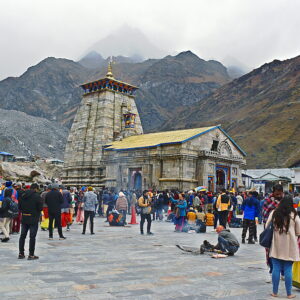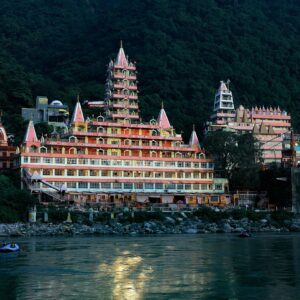The Chardham Yatra is one of India’s most revered spiritual journeys, drawing millions of devotees every year to the majestic Himalayas. The word Char Dham literally means “four abodes,” referring to the four sacred shrines—Yamunotri, Gangotri, Kedarnath, and Badrinath—that are considered the holiest pilgrimage sites in Hinduism.
Undertaking the Chardham Yatra is not just a religious obligation; it’s a life-changing experience that combines devotion, adventure, and the serene beauty of nature. Each of these temples is nestled high in the Garhwal region of Uttarakhand and holds deep spiritual significance.
In this detailed guide, we’ll explore the meaning, significance, itinerary, travel tips, and everything you need to know before embarking on the divine Chardham Yatra.
The Spiritual Significance of the Chardham Yatra
According to Hindu mythology, the Chardham Yatra cleanses the soul of all sins and paves the way for moksha (salvation). It is believed that visiting these four shrines in a single journey washes away all earthly impurities.
The four temples each represent a different manifestation of divine energy:
- Yamunotri – Dedicated to Goddess Yamuna, symbolizing purity and serenity.
- Gangotri – The origin of River Ganga, representing forgiveness and deliverance.
- Kedarnath – One of the 12 Jyotirlingas of Lord Shiva, embodying spiritual strength.
- Badrinath – The abode of Lord Vishnu, representing enlightenment and liberation.
Completing the Chardham Yatra in the traditional sequence—from west to east—has great significance, symbolizing the cycle of life and spiritual awakening.
Ideal Time to Undertake the Chardham Yatra
The Chardham Yatra typically begins in April or May when the temples open after winter and continues until October or early November before heavy snowfall.
Best Months to Visit
- May to June: Ideal weather, moderate crowds, and clear views.
- September to October: Post-monsoon freshness and fewer pilgrims.
During July and August, the region experiences monsoon rains, which may cause landslides, so travel is not recommended.
Chardham Yatra Route Overview
The traditional route of the Chardham Yatra follows a clockwise direction as per Hindu tradition. Pilgrims usually start from Haridwar or Rishikesh, two of India’s holiest cities, and then proceed as follows:
- Yamunotri → 2. Gangotri → 3. Kedarnath → 4. Badrinath
This sequence holds symbolic value—beginning with the goddess Yamuna and ending with Lord Vishnu—representing the journey from creation to liberation.
Detailed 10-Day Chardham Yatra Itinerary
Although many packages vary, here’s a standard 10-day Chardham Yatra itinerary that balances spiritual visits and comfortable travel.
Day 1: Arrival in Haridwar / Rishikesh
Begin your sacred journey in Haridwar or Rishikesh, where the Ganga flows serenely. Visit Har Ki Pauri for the evening Ganga Aarti, a mesmerizing ritual that sets the tone for your pilgrimage.
Overnight stay in Haridwar or Rishikesh.
Day 2: Haridwar – Barkot (Approx. 220 km / 8 hours)
Drive along the scenic route via Mussoorie and Kempty Falls toward Barkot, a serene base for visiting Yamunotri. Enjoy the stunning views of the Shivalik ranges.
Stay overnight in Barkot.
Day 3: Barkot – Yamunotri – Barkot (36 km drive + 6 km trek one way)
Drive to Jankichatti, the base for the 6 km trek to Yamunotri Temple, dedicated to Goddess Yamuna. You can trek or hire a pony/palanquin.
Take a holy dip in Surya Kund and offer prayers at the temple. Return to Barkot for an overnight stay.
Day 4: Barkot – Uttarkashi (Approx. 100 km / 4 hours)
After breakfast, proceed to Uttarkashi, located on the banks of the Bhagirathi River. Visit the Vishwanath Temple and explore the town. Overnight stay in Uttarkashi.
Day 5: Uttarkashi – Gangotri – Uttarkashi (100 km each way)
Early in the morning, drive to Gangotri Temple, dedicated to Goddess Ganga. En route, enjoy the scenic beauty of Harsil Valley—known for its apple orchards and tall deodar trees.
Take a dip in the holy Bhagirathi River and attend the temple aarti. Return to Uttarkashi for the night.
Day 6: Uttarkashi – Guptkashi (Approx. 220 km / 8 hours)
Drive through the picturesque landscapes of Tehri Dam and Srinagar to reach Guptkashi, a small town famous for the Ardhnareshwar Temple. Overnight stay at Guptkashi.
Day 7: Guptkashi – Kedarnath (30 km drive + 16 km trek)
After an early breakfast, proceed to Sonprayag and then trek or take a helicopter ride to Kedarnath, one of the 12 Jyotirlingas of Lord Shiva.
Offer prayers at the ancient Kedarnath Temple, surrounded by snow-capped peaks. The spiritual energy of this place is truly overwhelming.
Overnight stay in Kedarnath.
Day 8: Kedarnath – Guptkashi
After morning prayers, return to Guptkashi for relaxation and rest. The return trek offers panoramic Himalayan views that are simply breathtaking. Overnight stay at Guptkashi.
Day 9: Guptkashi – Badrinath (Approx. 190 km / 8 hours)
Drive toward Badrinath, the final destination of your Chardham Yatra. En route, stop at Joshimath and Narsingh Temple. Upon arrival, visit the Badrinath Temple, dedicated to Lord Vishnu, and attend the evening aarti. Overnight stay in Badrinath.
Day 10: Badrinath – Rishikesh / Haridwar (Approx. 300 km / 10 hours)
Visit Tapt Kund for a ritual bath before temple darshan. After breakfast, begin your return journey to Haridwar or Rishikesh, marking the completion of your divine Chardham Yatra.
Importance of Each Shrine in the Chardham Yatra
1. Yamunotri – Source of the Yamuna River
Located at 3,293 meters, this temple marks the origin of the Yamuna River. According to mythology, bathing in its waters purifies the soul.
2. Gangotri – Origin of the Ganges
At an altitude of 3,100 meters, Gangotri is believed to be where Goddess Ganga descended from heaven to cleanse humanity’s sins.
3. Kedarnath – The Abode of Lord Shiva
Situated at 3,583 meters, Kedarnath is one of the most sacred Jyotirlingas. The temple, built of massive stone slabs, is a symbol of unwavering faith.
4. Badrinath – The Home of Lord Vishnu
At 3,133 meters, Badrinath is part of both the Chardham and Bada Char Dham circuits. Lord Vishnu is worshipped here as Badrinarayan, symbolizing compassion and protection.
Tips for a Safe and Comfortable Chardham Yatra
- Physical Fitness: The journey involves high-altitude travel and trekking. Start mild exercise or walking a few weeks in advance.
- Clothing: Carry warm clothes, rain gear, and sturdy footwear.
- Health Precautions: Carry basic medicines and stay hydrated.
- Permits & Registrations: The Uttarakhand government requires pilgrims to register for the Chardham Yatra online or at official counters.
- Avoid Plastic & Littering: Help preserve the pristine beauty of the Himalayas.
- Travel Insurance: Always opt for travel insurance for emergencies.
Helicopter Services for the Chardham Yatra
For pilgrims short on time or unable to trek, helicopter services are available from Dehradun, Phata, Sersi, and Guptkashi.
The Chardham Yatra by helicopter typically covers all four shrines within 2–3 days, offering breathtaking aerial views of the Himalayas and comfortable travel.
Accommodation Options During the Chardham Yatra
You can find a range of accommodations along the route:
- Budget: Dharamshalas, GMVN guest houses, and local lodges.
- Mid-Range: Decent hotels with basic amenities.
- Luxury: Premium resorts and camps in Rishikesh, Joshimath, and near Badrinath.
Advance booking is recommended during the peak season (May–June).
Chardham Yatra Packages
Various travel operators offer Chardham Yatra packages ranging from 10 to 14 days, covering transportation, meals, accommodation, and guided temple visits.
You can also choose from:
- Chardham Yatra by Road (Economical)
- Chardham Yatra by Helicopter (Premium & Time-Saving)
- Do Dham / Ek Dham Packages (Shorter Pilgrimages)
Choose the package that best suits your schedule, budget, and health conditions.
Why Undertake the Chardham Yatra?
The Chardham Yatra is more than a journey—it’s a path of devotion, self-discovery, and surrender. It allows devotees to disconnect from worldly distractions and experience divine peace in nature’s lap.
Every temple visit, every step on the Himalayan trail, fills the heart with spiritual energy and gratitude. Whether you go for faith, adventure, or inner peace, the Chardham Yatra transforms your soul forever.
Conclusion
The Chardham Yatra is one of India’s most sacred pilgrimages, blending spiritual devotion with Himalayan beauty. Visiting Yamunotri, Gangotri, Kedarnath, and Badrinath not only purifies the mind and soul but also offers a deep connection with divinity and nature.
As you chant the holy names along the icy rivers and towering peaks, you’ll realize that the Chardham Yatra is not just a journey through the mountains—it’s a journey within yourself.
So, when the Himalayas call, answer with faith in your heart—the path to salvation awaits in the divine Chardham Yatra.





